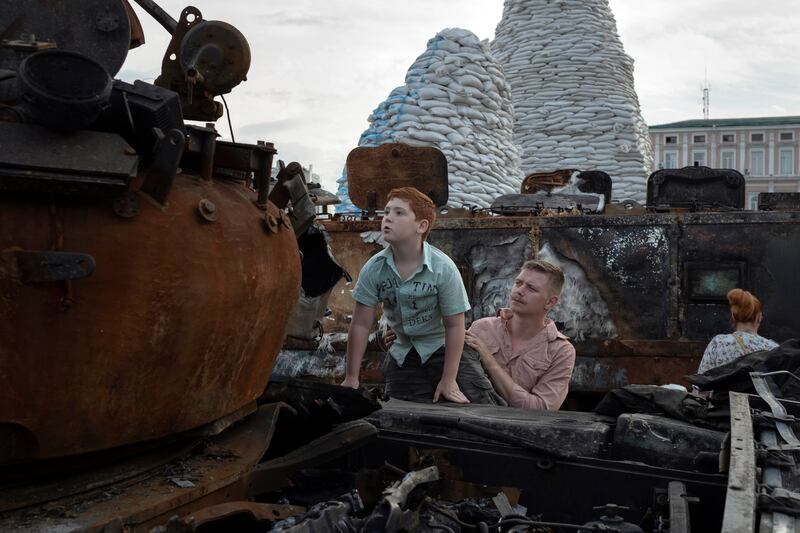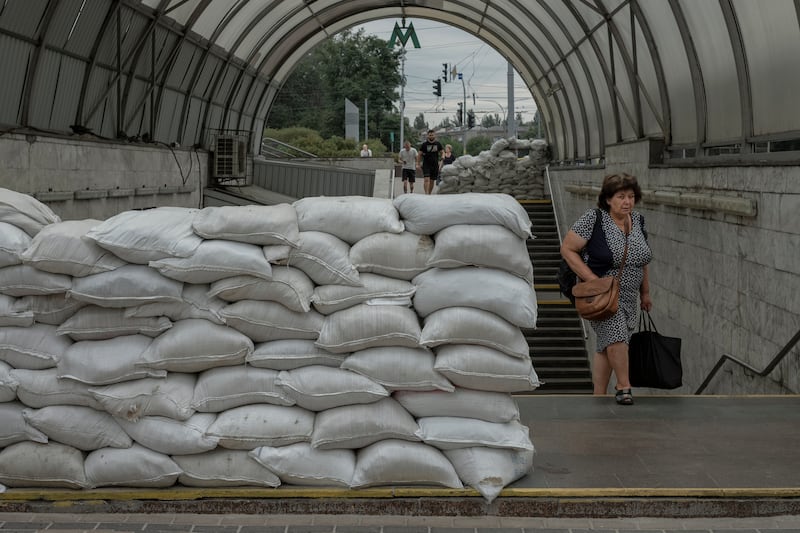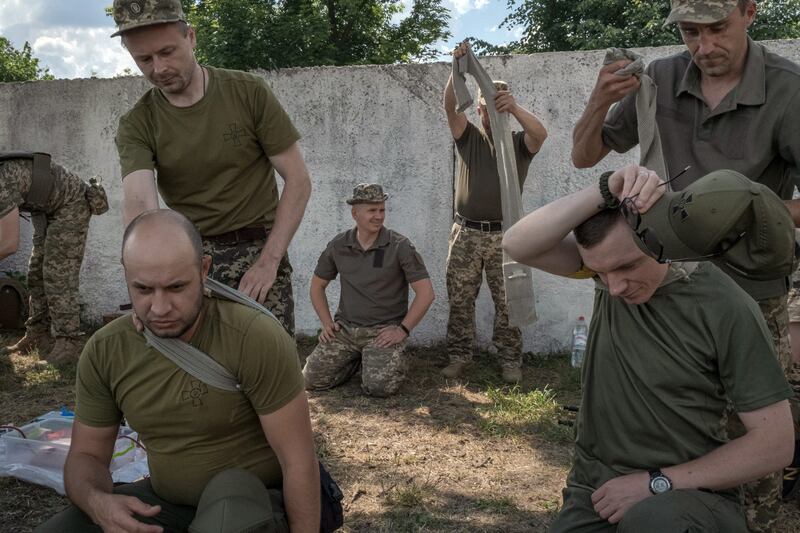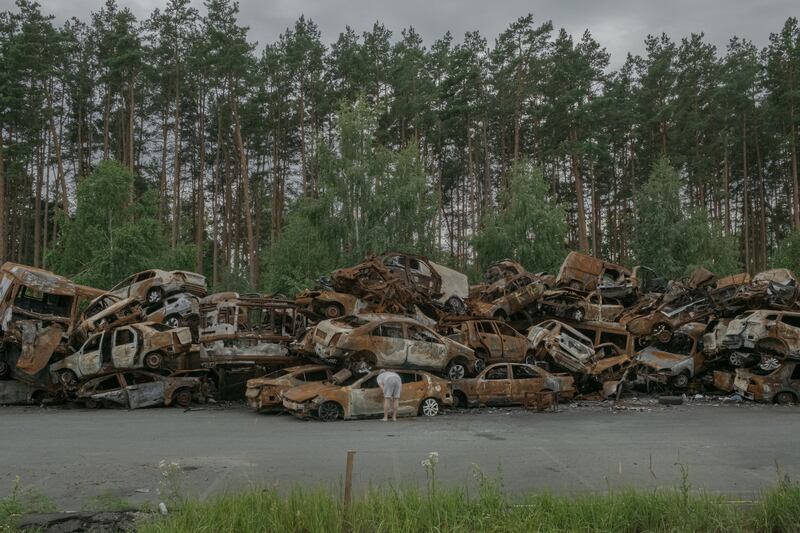Russia’s capture of the cities of Sievierodonetsk and Lysychansk, a significant victory for Moscow’s campaign to conquer eastern Ukraine, demonstrates the success of the Russian military’s grinding strategy based on superior firepower and incremental advances.
It also raises serious questions about how long either side can keep going like this, particularly the battered and vastly outgunned Ukrainian forces, forced to rely on raw recruits and suffering heavy casualties, along with the mental strain of combat, retreat and constant Russian shelling.
Russia’s invasion has taken a brutal toll on its own forces as well, but they continue their slow advance, and with the seizure of Lysychansk at the weekend, they have taken control of the entirety of Luhansk province, putting them in position to push on toward Ukrainian-held cities in Donetsk province.
The devastating strategy, relying heavily on long-range artillery, suits the flat terrain and shorter Russian supply lines in the east, but might not work elsewhere. And it remains unclear how far President Vladimir Putin intends to press the offensive, or how much more loss of men and materiel his military can absorb without needing a long pause to rebuild.

Ukrainian officials say their goal is to inflict maximum pain on the Russians by forcing them to fight for cities, as happened in Sievierodonetsk and to a lesser extent in Lysychansk, but both cities fell, and now there are rising doubts about that approach. The strategy is also divisive among Ukrainian troops, some of whom believe that attempting to hold cities is fruitless.
“For me, human life is more important than the name Lysychansk,” Lt Col Yurii Bereza (52), a battalion commander in Ukraine’s National Guard, said days before the Ukrainians decided to abandon the city rather than fight block by bloody block, as they had in neighbouring Sievierodonetsk.
Volodymyr, a volunteer soldier who was one of the last members of his unit to pull out of Sievierodonetsk in June, said he had lost more than half his company of around 100 soldiers during the battle. He summarised the battle with an expletive. “What support?” he asked. “There was no support.”
He nodded, however, at the Ukrainian T-80 tank across the street, saying tank units did come to the soldiers’ aid when artillery backup did not.

Early in the war, Russian forces attempting to quickly seize Kyiv, the capital, overextended their troops and armoured columns, leaving them with little support, and suffered a stinging defeat by the Ukrainians. Moscow then shifted its focus to the mineral-rich, industrial Donbas region in the east – Luhansk and Donetsk – and changed its strategy.
Now, Russian troops rarely advance without an overwhelming amount of backing, often in the form of heavy artillery bombardment – even if that means that what Moscow captures is in ruins. Ukrainian soldiers say that the shelling lasts for about five days before Russian forces begin testing Ukrainian lines with foot soldiers and tanks.
[ How a former TV presenter raised €19m in three days to fund Ukrainian militaryOpens in new window ]
The fighting has clearly exhausted both sides. Ukrainian officials have estimated that their forces are suffering hundreds of casualties a day; Western intelligence puts Russian deaths and injuries at a similar level.
Ukrainian forces are increasingly relying on lesser-trained troops such as those from the territorial defence forces and National Guard to supplement exhausted units on the front lines. And Russia has turned to reinforcements such as Wagner paramilitary units, pro-Moscow Chechen forces and separatist fighters from Luhansk and Donetsk to reinforce their casualty-plagued units.
On Monday, Putin ordered that the troops involved in capturing Lysychansk and Sievierodonetsk rest and “increase their combat capabilities” while other Russian formations continue fighting.

Both sides have played down reports of faltering morale in their ranks, sometimes posting motivational videos on social media to counter the notion that anyone in the trenches is exhausted. And even as casualties wear them down, Ukrainian troops are displaying a willingness to continue fighting, no matter the cost.
“We’ll go back” said Volodymyr, after retreating from Sievierodonetsk. “This is our land. This is how it is.”
But this method of fighting – an artillery war – can produce intense psychological trauma, much as in the first World War, the conflict that gave rise to the term “shell shock”. Ukrainian commanders, especially of replacement units, worry that some of their soldiers are suffering from stress, on top of the risk of being wounded or killed by enemy fire.
“During the artillery shelling, all you can do is lay in the shelter and wait for the shelling to end,” said Volodymyr, a Ukrainian platoon commander who recently came off the front in the Donbas. “Some people get mentally damaged because of such shelling. They are found to be psychologically not ready for whatever they encounter.”
Volodymyr, who declined to provide his surname out of security concerns, said that one person had been killed in his platoon and two had had to leave the front because of mental trauma.
More than four months into the war, Ukrainians remain angry and defiant. But among civilians – millions of them displaced, out of work and living in fear, some lacking adequate food, water and electricity – the mood is increasingly sombre. As the Russians gain ground and losses mount, with no end in sight, some Ukrainians accuse their government of minimising the challenges ahead in a bid to raise morale.

Yulia Fedotovskyh (32), a public relations manager in Kyiv, said that earlier in the war, scrolling images on social media of dead Russian soldiers helped her feel safer. Now, she says, she just tries to avoid the news.
“I realise and have accepted that I can die at any moment, and so I just live my life,” she said.
In an early sign of the violence likely coming, Russian forces have increased their shelling of population centres near the front lines in recent days.
[ Ukraine’s second city wakes to war, Daniel McLaughlin reports from KharkivOpens in new window ]
At least six people were killed in Sloviansk on Sunday and more than a dozen were injured by Russian rockets, Ukrainian authorities said. In a Facebook post, Vadym Lyakh, the mayor of Sloviansk, said it was the city’s most severe shelling since the Russian invasion began on February 24th. The head of the regional military administration, Pavlo Kyrylenko, said on Monday in a post on the Telegram messaging app that Russian forces had killed nine civilians in Donetsk province in the previous 24 hours.
In his nightly video address, President Volodymyr Zelenskiy warned that the Russians “have now accumulated their largest firepower in Donbas, and they can use tens of thousands of artillery shells every day on one section of the front”.
But he vowed once again to retake the lost territory. “We will return,” he said, “thanks to our tactics, thanks to the increase in the supply of modern weapons”.

In the south, near the Russian controlled port-city of Kherson, Ukrainian forces have made a series of small gains over the past month. And though military analysts say these incremental victories are a sign of a coming broader counteroffensive, Ukrainian military officers have downplayed the fighting and acknowledged that the focus is on the east.
Kyiv has frequently called for more Western-supplied weapons and ammunition. And while some have made it to the front and proved successful in combat, especially the recently arrived Himars multiple rocket launch system from the United States, any longer-term Ukrainian success on the battlefield would require much more.
“There is a problem with ammunition,” Bereza said. “For example, for our one shot, they would fire 50 shots. How can you fight this?”
But he said the situation had improved somewhat, and that “we are waiting for the help from the West with artillery, with machines”.
Ammunition shortages in the Ukrainian military, especially for its Soviet-era long-range artillery pieces, have left its forces transitioning between that weaponry and newer, Western-supplied equipment that requires extensive training. The United States and its allies are providing that training outside Ukraine, but the pace is not meeting the demand, and some of those trained have been killed or injured.

A Ukrainian officer who works with US-supplied M777 howitzers said that several officers and howitzer gunners who trained in Latvia had been killed or wounded during the fighting.
“The artillery from the enemy worked 24/7, and our artillery could do something three or four times a day,” said Olena, a military medic who declined to provide her surname out of security concerns. “And then it could miss the target. There were problems with correcting the fire.”
For both sides, air support has mostly been a secondary part of the fighting in Donbas, or even absent. Russia and Ukraine both have significant air defences in place in the east, meaning that most jets and helicopters have to fly dangerously low to provide a modicum of support for ground forces. That has left Russian forces firing cruise missiles to target key infrastructure behind the front lines.
In recent days, the General Staff of the Ukrainian Armed Forces said, its forces had carried out more than a dozen air missions in Ukraine’s south and east, destroying some Russian equipment. Last week, a Ukrainian Su-24 ground attack aircraft was seen flying at treetop level toward Lysychansk, a rarity in the Donbas. – This article originally appeared in The New York Times.
2022 The New York Times Company









